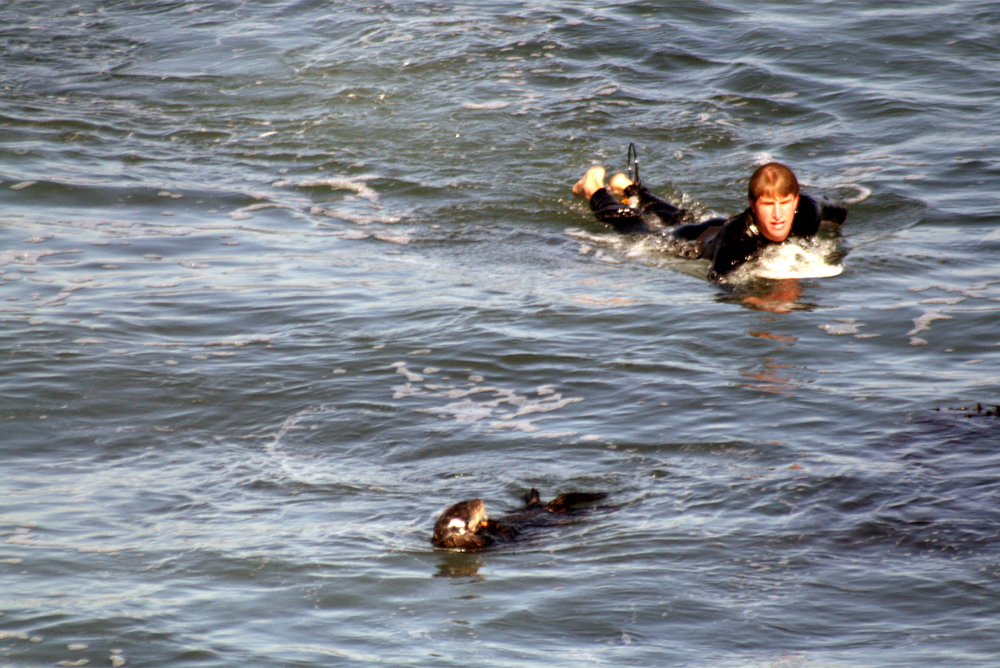
Government officials and the media call me a threat when they should regard me as an asset to the California coast, complains Santa Cruz’s “aggressive” otter. Courtesy of Brocken Inaglory/Wikimedia Commons (CC BY-SA 3.0).
Who are you to be calling me aggressive?
Yes, I’m the 5-year-old female otter from the waters off Santa Cruz, about whom you’ve been reading scary headlines.
Now, I do sometimes approach surfers or kayakers in ways that they interpret as threatening. It’s also true that, on occasion, I separate surfers from their boards, and exercise my right, as a Californian, to ride the waves myself.
But have I ever done anything aggressive, at least by Santa Cruz standards? It’s not like I ever swiped a street parking space near the Boardwalk, or bid $200,000 over asking on a three-bedroom in Seabright.
Which is why it’s downright slanderous to say, as the city of Santa Cruz has on signs posted near the coast, that I’m an “aggressive sea otter” so dangerous that people shouldn’t go in the water. It’s offensive that the U.S. Department of Fish and Wildlife speculates that my behavior “may be associated with hormonal surges”—hey, feds, you can’t say that about a female anymore!
And if I could find a lawyer, I might have a case against those biased human media who have called me “wayward,” “rogue,” and a “renegade”—without ever bothering to ask me for comment.
The real aggressors in this otter’s story are all too human. And I’m not just talking about the paparazzi who, now that I’ve made the international news, are paddling out into the Santa Cruz waves to try to take my photo.
As of this writing, there are no confirmed cases of me hurting anyone, according to the U.S. Fish and Wildlife Service. Still, I’m being relentlessly hunted, by state officials and the Monterey Bay Aquarium, as if I were a dangerous fugitive.
Yes, I’ve bitten a few holes in some boards. But c’mon! Human Californians can shoplift in Union Square, steal catalytic converters on Nob Hill, and smoke meth in the Tenderloin without any real fear of prosecution, much less imprisonment.
This otter spooked a few surfers, and my freedom is at stake. For now, the state’s plan is to capture me (they may have succeeded by the time you read this) and remove me from my home in the Santa Cruz waters. Eventually, they would relocate me to a zoo or aquarium, placing me in front of audiences with little compensation besides a few meals—like a character actor in a Netflix show.
But it could get worse for me. Experts have raised the possibility that, if I’m ever accused of doing harm to a human, I’ll be euthanized—without a trial before a human jury, much less a panel of my fellow marine mammals.
And you thought Governor Newsom had put a moratorium on executions.
Of course, deadly attacks on otters are a human tradition. There are only around 3,000 of us southern sea otters living off the California coast today because of mass slaughter by fur traders of the 18th and 19th centuries.
So, don’t I have every reason to bite back?
I am among the otters born in captivity and returned to the wild, with a number (841) and a transmitter for monitoring. My mother, according to reports, showed what the humans call aggression, perhaps because they fed her.
After I was first reported for “aggressiveness” a couple years ago, a team of state and aquarium officials yelled loudly at me and beat a paddle in my direction in an effort to make me afraid of people. This intervention didn’t work, which is no surprise.
I can’t really help it if I run a little hot. My metabolism requires that I eat one-quarter of my body weight each day in fish and crab and urchins. I have to eat even more when I’m pregnant. It’s also hard for me to keep warm; I don’t have blubber like those media darlings, the elephant seals.
If I weren’t a fugitive, I might find it funny, or at least ironic, that I’m in trouble for confronting surfers. Because surfers, who constantly paddle right into my ecosystem, are far more aggressive than me. Santa Cruz has a long history of surfers who defend their breaks violently, and even create gangs. But I’m the threat here?
To the contrary, I should be seen as an asset, even a model for Californians. I’m out here breeding—two pregnancies so far that anyone knows about—while the human birth rate is dropping so fast onshore that California is losing population. My presence, and that of other sea life, is vital to the tourism that powers the Central Coast economy. I’m also an environmental steward, because I eat the sea urchins that can devour kelp forests. The same state government now hunting me has considered introducing otters along the North Coast, to make those ecosystems healthier.
Despite all we do for society, my fellow otters and I are excluded from participation in decisions in California, even as the state seeks to control me. This is primitive, and hypocritical for a state that purports to be committed to democracy and environmental justice. Efforts are underway, here and elsewhere, to create multi-species constitutions and democratic governance for important commons spaces on this planet, like the Amazon or the oceans.
As the University of Leicester politics professor Rob Garner has written, “the interests of animals are affected—often devastatingly—by collective decisions and, therefore, they, or—more specifically—their representatives, have a democratic right to have some say in the making of those decisions.”
I shouldn’t be evading state officials. I should be helping to govern them. Because the real aggression I see in California is your anthropocentrism.




Send A Letter To the Editors